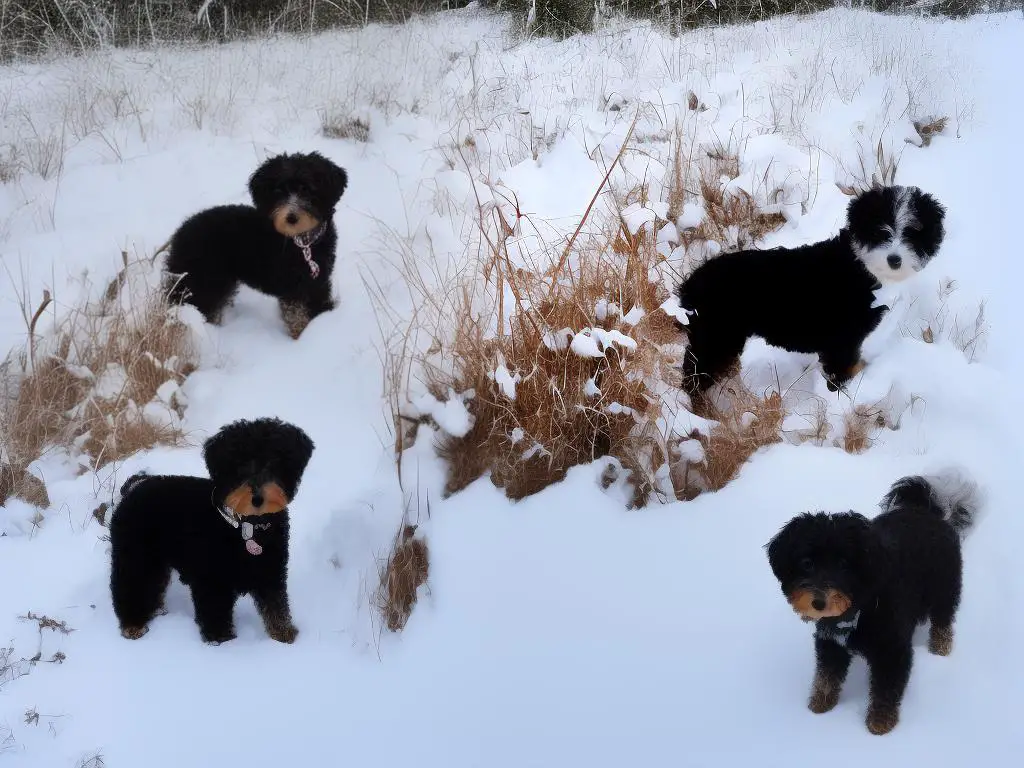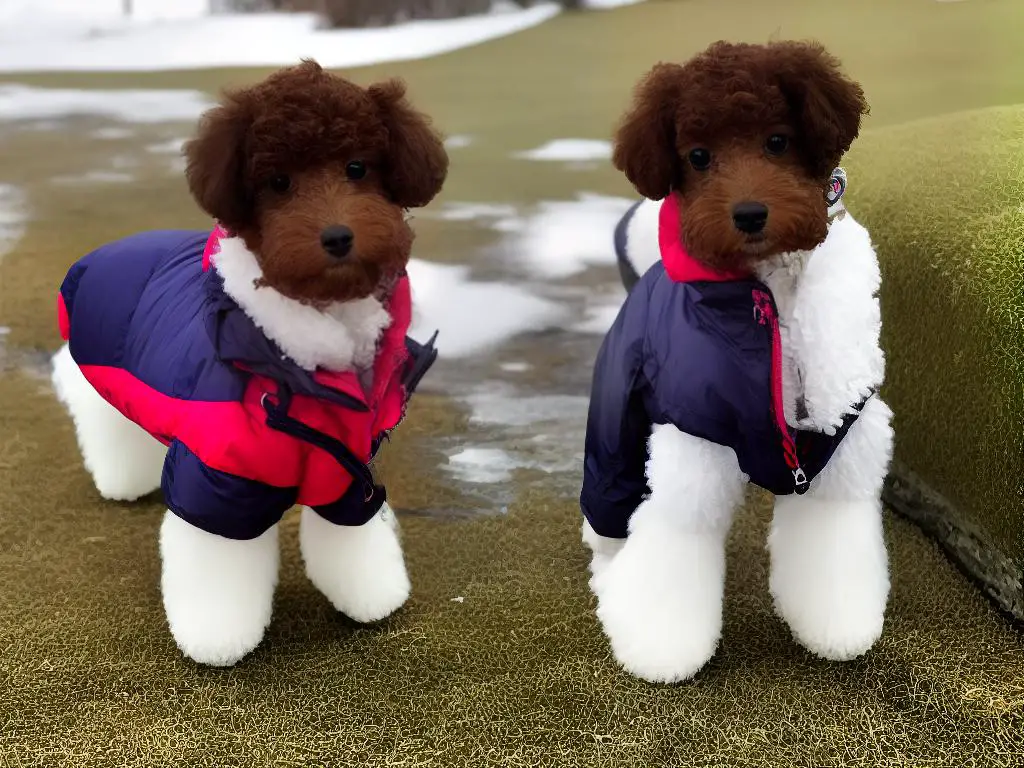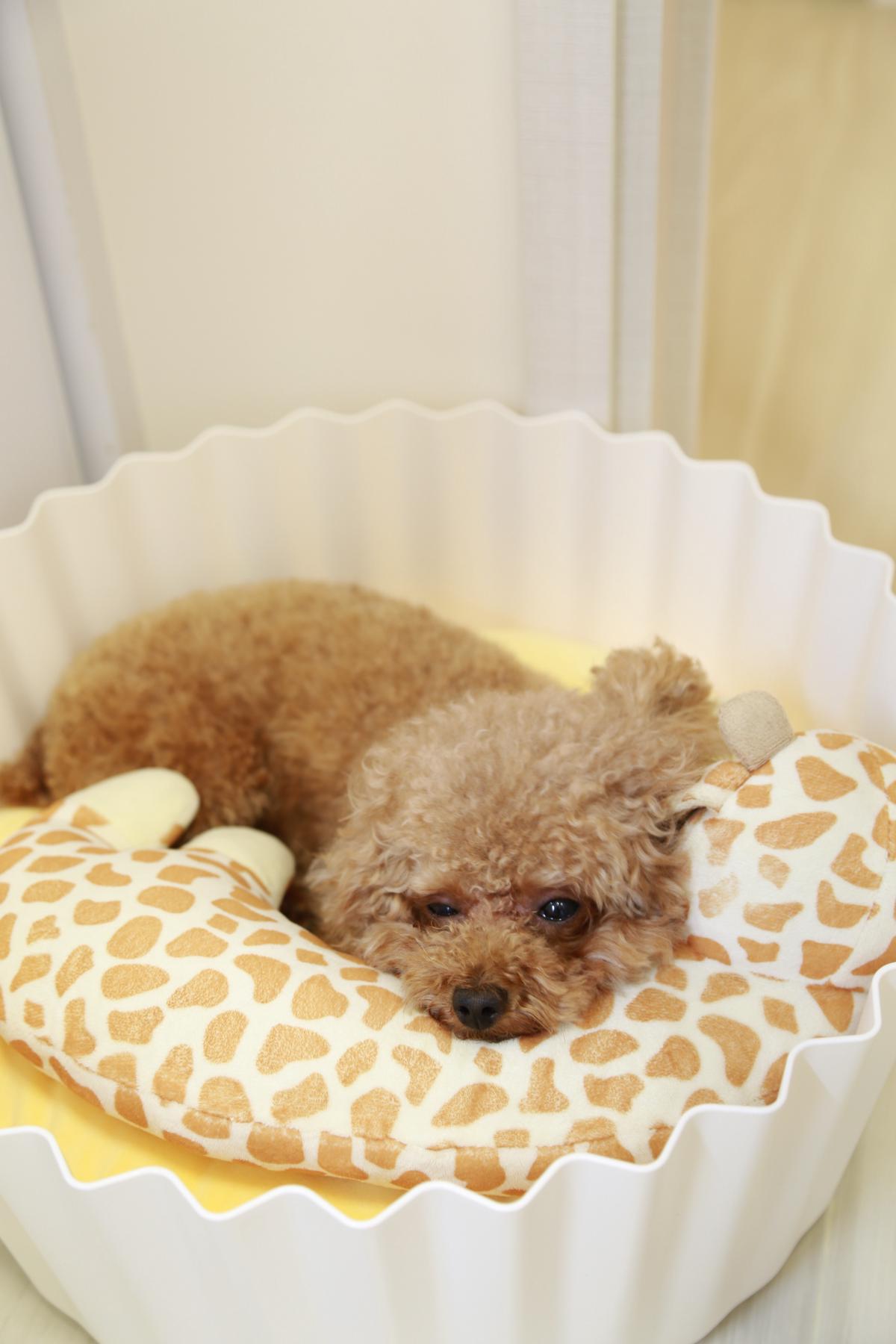Teacup Poodle Winter Care: A Comprehensive Guide
When the frosty, winter air starts to roll in, it ushers in a slew of changes in our lives and routines – from cozy sweaters to comforting hot chocolate. However, this chilly season also brings with it a new set of needs for our diminutive, lovable companions, the teacup poodles. Adapting to their specific requirements during this icy period is critical in ensuring their well-being and happiness. As we venture into the realms of the specific winter needs of a teacup poodle, from understanding their physiological responses to the cold to investing in appropriate winter gear; from guaranteeing their indoor comfort to tweaking their diet for this season, we equip ourselves with the knowledge and power to provide the best care for our four-legged friends. Let’s take an in-depth look at how to transform the winter season into a delightful experience rather than a dreadful ordeal for our teacup poodles.
Understanding Teacup Poodle’s Specific Needs in Winter
Teacup Poodles: A Peek into Their Basic Biology and Natural Habitat
Teacup Poodles, often mistaken for being a distinct breed, are in reality Toy Poodles that have been specifically bred to retain a surprisingly small size. They typically weigh less than 5 pounds and stand shorter than 9 inches. Despite their delicate size and appearance, these tiny canines can be quite vigorous and agile.
The origin of Poodles, including their tiny Teacup counterparts, can be traced to Europe. They were initially bred in Germany for retrieving waterfowl, but their versatility quickly made them companions of the French aristocracy. Given their history, Teacup Poodles are better suited to milder climates and have a low tolerance to low temperatures.
Distinct Physical Traits: Teacup Poodle Hair Type and Metabolism
Teacup Poodles boast a dense, curly coat that is hypoallergenic and virtually non-shedding. While such a coat might seem warmer than that which other breeds possess, it does not offer much insulation against chilly winter months. They also have a faster metabolism, meaning they burn calories quicker and can easily get cold due to their tiny body size and less body fat.
Susceptibility to Cold in Teacup Poodles
Due to their small stature and fast metabolism, Teacup Poodles, much like other small dog breeds, are more prone to hypothermia and frostbite during winter. Their tiny bodies lose heat rapidly when the temperature in their environment drops. Extra precautions like off-floor and cozy sleeping arrangements, warm clothes, and limiting the time spent outdoors in cold weather help to keep these small pets comfortable and reduce health risks.
Understanding Age and Health Concerns for Wintertime Care
Regardless of age, Teacup Poodles require special attention in the winter because of their petite stature and short coats. However, age and preexisting health issues can further contribute to their sensitivity to cold weather. Puppies, senior dogs, and those already managing conditions such as diabetes, heart disease, or arthritis are particularly susceptible to the cold.
- Puppies, due to their underdeveloped full coat and fat reserves, are extremely vulnerable to cold spells.
- Elderly Poodles with weakened immune systems may have a harder time maintaining body heat.
- Dogs grappling with health concerns like arthritis might see their symptoms deteriorate during winter.
All things considered, a comprehensive awareness of their age and health conditions is paramount to their winter care. A careful, informed approach can remarkably benefit their overall well-being and joy of life during the frigid days.

Essential Winter Gear for your Teacup Poodle
Gearing up for the Cold: Striking a Balance between Comfort and Practicality
Teacup poodles, endearing for their tiny size and captivating charm, need special care during the winter to guarantee their comfort, safety, and health. An integral part of this care is the appropriate choice and usage of winter gear, featuring items such as winter coats, boots, and indoor accessories.
The Significance of Winter Coats
For Teacup Poodles, winter coats are far more than fashion apparels. Due to their small size and scant body fat, these breeds find it challenging to retain body heat in chilly temperatures. A snug, insulating winter coat can provide the essential warmth whether you’re out for a leisurely walk or they’re having fun in the backyard.
In selecting a coat, materials such as fleece or sherpa that provide good insulation are recommended. The coat should shield a significant part of your poodle’s physique, including the chest and belly areas. Furthermore, it should fit correctly in order to permit your poodle to move comfortably and freely. A tight coat can limit movement, while a loose one may fail in affording the desired warmth.
Boots: More Than Just Adorable Footwear
Winter boots may seem an odd choice for a dog, but for teacup poodles, they are incredibly useful. Salt, which is often used to melt snow and ice on pavements, can be harsh on a poodle’s sensitive paw pads. Likewise, ice and cold pavement can cause discomfort or even lead to frostbite in extreme conditions.
Select boots that are water-resistant and well-insulated, with a non-slip sole that ensures secure footing. As with coats, a proper fit is key. Too loose, and the boots might fall off; too tight, and they might cut off circulation.
Indoor Comfort: Ensuring a Cozy Environment at Home
For Teacup Poodles, winter care continues even inside the house. They can sometimes feel the chill even inside, hence, it is necessary to enhance their indoors with suitable accessories. For instance, think about providing them heated dog beds or heating pads to offer them a snug place.
Low humidity levels in the house due to indoor heating during winters can commonly cause dry skin in these poodles. To counter this, installing humidifiers can go a long way in maintaining their skin health.

Indoor Comfort and Care for Teacup Poodles in Winter
Getting to Know Your Teacup Poodles’ Winter Requirements
Caring for Teacup Poodles inside the home during winter is a box of challenges and requires a strategic approach. Owing to their petite and fragile nature, teacup poodles can be a lot more vulnerable to chilling weathers, exposing them to potential health risks. Thus, it is essential to ensure a warm indoor environment for them.
Maintaining Indoor Temperature
Teacup Poodles are more prone to hypothermia due to their small size. They should be kept in an environment where the temperature is consistently kept between 70 and 75 degrees Fahrenheit. To achieve this, you can use room heaters, while being careful to ensure they are not exposed to direct heat, which could cause overheating.
Winter Potty Training
Due to the cold outdoor temperatures during winter, it is often advisable to potty train your Teacup Poodle indoors. You can use puppy pads or an indoor dog potty, which can be lined with newspapers or disposable diapers. Always ensure to clean the potty area regularly to maintain proper hygiene.
Ensuring Adequate Playtime and Exercise
Despite the cold conditions, Teacup Poodles need regular exercise to stay healthy. Indoor playtime can incorporate stimulating games that challenge their intelligence. You can use toys and puzzles designed for small dog breeds. Another way is to set up playdates with other small dogs.
Additionally, Teacup Poodles can be trained to use treadmills designed for small breeds, to maintain their physical health during winter months.
Skin and Coat Health During Winter
Teacup Poodles’ coat acts as an insulator and helps them retain body heat. Therefore, regular grooming is imperative to keep the coat healthy and efficient in performing this function. You should also consider dressing your Teacup Poodle in a warm dog sweater or coat, especially when the heating is turned on, to prevent dry skin due to indoor heating systems.
You should also keep them hydrated by ensuring they have constant access to fresh drinking water. This helps in preventing dry skin and maintaining overall good health.
Remember, a balanced diet is essential for maintaining their skin and coat health. Therefore, provide them with dog food rich in omega-3 fatty acid, to help keep their skin moisturized and their coat shiny. Always consult with your vet for the appropriate diet for your Teacup Poodle.
Other Considerations for Winter Care
Other considerations for winter care include taking them out for brief, supervised periods and avoiding walks during the peak cold times of the day. This ensures they get the necessary stimulation without being exposed to harsh winter conditions.
Regular check-ups with your vet are equally as important, as they can monitor your dog’s health and recommend suitable winter care procedures.
To ensure that your Teacup Poodle remains content, healthy, and vibrant during the frosty season, a multi-faceted approach is essential. Providing them with cosiness and warmth, engaging them in suitable play and exercise, and diligently looking after their skin and coat all make up the blueprint for effective teacup poodle winter care.

Photo by alisonpang on Unsplash
Teacup Poodle Winter Nutrition and Health
Fuelling Your Teacup Poodle in Winter: Adjusting Diet for the Chilly Season
As part of your winter care strategy for your teacup poodle, nutrition is paramount. The chillier time of the year calls for diet modifications to maintain your tiny poodle’s health and vitality.
Bearing in mind that teacup poodles, familiar for their petite size, possess a faster metabolism, burning calories at a quicker pace is crucial, especially during the colder months when their bodies strive to sustain warmth. Additionally, bearing in mind their smaller stomach capacity, it’s more practical to provide them smaller servings more often.
In the winter season, it’s advisable to increase the calorie intake of your teacup poodle by about 10-20%. Always keep tabs on your pet’s weight and adjust the portion size accordingly, being mindful not to overfeed them which can result in obesity and other health complications. Make certain also, that the meals you provide are packed with high-quality proteins and fats.
Just as in the warmer months, ensuring your poodle stays hydrated during winter is equally crucial. Despite the firmer grip of the cold weather which might cause your poodle to seemingly drink less, the risk of dehydration remains. Always ensure that fresh water is readily available. For a more appealing option on those colder days, consider serving warm broth -an excellent source of both fluids and nutrients.
Winter Health Risks: Potential Perils in the Cold
Considering their tiny size and slender coat, teacup poodles are at risk in the cold. They may experience hypothermia and frostbite if exposed to extremely cold environments for prolonged periods.
Beyond the bone-chilling weather, the winter season can usher in risks such as respiratory issues, dry skin, and arthritis exacerbation. Be watchful for signs such as excessive shivering, lethargy, cold body, dry or flaky skin, difficulty breathing, or hesitance in movement.
Health Check at Home: Your Role in Winter Care
As a responsible pet parent, there are several health checks you can perform at home. Regularly check your poodle’s paws for ice balls or salt crystals that can cause discomfort or damage. Lanolin-based paw protections can also be beneficial in preventing chapping and cracking.
Monitor your poodle’s skin condition, ensuring they’re not suffering from dryness or potential allergies. A humidifier can help maintain optimal moisture levels in the indoor air.
It’s also a good idea to keep an eye on your poodle’s body temperature. Teacup poodles usually have a body temperature between 101 and 102.5 degrees Fahrenheit. Hypothermic dogs may show a lower temperature, lethargy, and lack of coordination.
Engaging with Professional Care: Knowing When to Consult a Vet
Caring for your teacup poodle at home is effective to an extent, but nothing replaces professional medical care. You should promptly contact your vet if your teacup poodle exhibits peculiar symptoms or behaviors.
Indicators that call for veterinary intervention include significant coughing, constant lethargy, a decrease in appetite, weight changes, intense shivering, or any abrupt behavioral changes.
Furthermore, it’s recommended to discuss your winter care regimen with your vet. They will be able to offer personalized advice in line with your poodle’s age, health circumstances, and living environment. Routine vet appointments are crucial for preventative care, ensuring your teacup poodle remains healthy throughout the colder season.

Photo by alisonpang on Unsplash
Dealing with Potential Emergencies or Health Issues
Identifying Winter Risks for Teacup Poodles
Winter conditions can pose several dangers to the well-being of teacup poodles. Due to their petite size and minimal natural insulation, they’re notably vulnerable to harsh winters. As the owner, recognizing potential risks is vital, including dangers like hypothermia, frostbite, and injury to paws resulting from ice or salted walkways.
The Peril of Hypothermia and Frostbite
Hypothermia can develop when a dog’s body temperature falls dangerously below its normal range of approximately 101 to 102.5 degrees Fahrenheit. Symptoms may encompass shivering, fatigue, and in severe cases, even loss of consciousness.
Frostbite, another severe winter ailment, occurs when parts of the poodle’s body, such as the ears, tail, or feet, freeze. Discoloration in the impacted area, inflammations, blisters, and sensitivity to touch are indicative of this condition.
Ensuring Immediate Care: Hypothermia and Frostbite
In case of hypothermia, try to gradually warm your poodle’s body using warm (not hot) cloths or a warm water bottle wrapped in a towel placed against the dog’s body. Do not use direct heat sources like heating pads, as they can cause burns. If your dog shows severe symptoms, seek immediate veterinary attention.
If you suspect your dog has frostbite, warm the affected area gently with warm (but not hot) water for 15 to 20 minutes. Do not rub or massage the area as this might cause further damage. Like hypothermia, severe frostbite cases would require urgent veterinary care.
Potential Paw Injuries: Ice and Salt Dangers
The winter season brings its share of icy and salt-covered walkways. These conditions can injure your poodle’s paws, causing painful cracks or burns. After each walk, check and wipe your dog’s paws to remove any ice or salt accumulation.
Contacting the Veterinarian
Any major concern for your teacup poodle’s health should prompt a visit to the veterinarian as tiny dogs are at a higher risk of complications from these conditions. Veterinarians can provide the necessary treatment and give advice on how to prevent these conditions in the future.
Summary of Winter Care
As a teacup poodle owner, it’s essential to be well-informed about winter weather hazards and how to manage potential emergencies that may arise. With careful observation, prompt response to symptoms, and effective communication with your vet, you can ensure the safety and well-being of your beloved pet during the colder months.

With the curtains falling on our comprehensive exploration of teacup poodle winter care, it’s evident that this small bundle of joy requires a meticulous blend of warmth, safety, and health regimen to flourish in the colder months. Whether it’s the added layer of clothing, the careful watch on their diet, or the extra attention for indoor comfort, every step plays a pivotal role in ensuring their physical well-being and emotional contentment. Additionally, being prepared for any winter-related emergencies empowers us to avert potential health risks and offer immediate help. As we embark on this winter journey with our furry companions, let the knowledge we’ve accumulated guide us in painting a safe, joyful winter canvas for our teacup poodles. Let’s make winter not a challenge, but a season of joy for our tiny friends.
